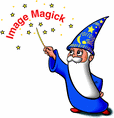

| mogrify - mogrify an image |
|
mogrify [ options ... ] file ...
|
|
Mogrify transforms an image or a sequence of images. These transforms
include image scaling, image rotation, color reduction, and others. The
transmogrified image overwrites the original image.
|
|
To convert all the TIFF files in a particular directory to JPEG, use:
mogrify -format jpeg *.tiff
To convert a directory full of JPEG images to thumbnails, use:
convert -size 120x120 *.jpg -geometry 120x120 +profile '*'
To scale an image of a cockatoo to exactly 640 pixels in width and 480 pixels in height, use:
mogrify -geometry 640x480! cockatoo.miff
|
|
Options are processed in command line order. Any option you specify on the command line remains in effect for the set of images that follows, until the set is terminated by the appearance of any option or -noop.
For a more detailed description of each option, see
ImageMagick(1).
For a more detailed description of each option, see
ImageMagick(1).
|
|
Use -segment to segment an image by analyzing the histograms of the color components and identifying units that are homogeneous with the fuzzy c-means technique. The scale-space filter analyzes the histograms of the three color components of the image and identifies a set of classes. The extents of each class is used to coarsely segment the image with thresholding. The color associated with each class is determined by the mean color of all pixels within the extents of a particular class. Finally, any unclassified pixels are assigned to the closest class with the fuzzy c-means technique. The fuzzy c-Means algorithm can be summarized as follows:
The fuzzy c-Means technique attempts to cluster a pixel by finding the local minima of the generalized within group sum of squared error objective function. A pixel is assigned to the closest class of which the fuzzy membership has a maximum value. For additional information see: Young Won Lim, Sang Uk Lee, ``On The Color Image Segmentation Algorithm Based on the Thresholding and the Fuzzy c-Means Techniques'', Pattern Recognition, Volume 23, Number 9, pages 935-952, 1990. |
|
|
John Cristy,
[email protected],
ImageMagick Studio LLC, |
|
Copyright (C) 2002 ImageMagick Studio Permission is hereby granted, free of charge, to any person obtaining a copy of this software and associated documentation files ("ImageMagick"), to deal in ImageMagick without restriction, including without limitation the rights to use, copy, modify, merge, publish, distribute, sublicense, and/or sell copies of ImageMagick, and to permit persons to whom the ImageMagick is furnished to do so, subject to the following conditions: The above copyright notice and this permission notice shall be included in all copies or substantial portions of ImageMagick. The software is provided "as is", without warranty of any kind, express or implied, including but not limited to the warranties of merchantability, fitness for a particular purpose and noninfringement.In no event shall ImageMagick Studio be liable for any claim, damages or other liability, whether in an action of contract, tort or otherwise, arising from, out of or in connection with ImageMagick or the use or other dealings in ImageMagick. Except as contained in this notice, the name of the ImageMagick Studio LLC shall not be used in advertising or otherwise to promote the sale, use or other dealings in ImageMagick without prior written authorization from the ImageMagick Studio. |